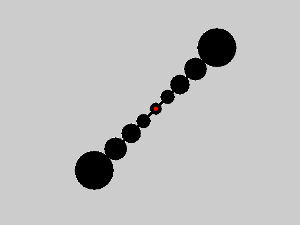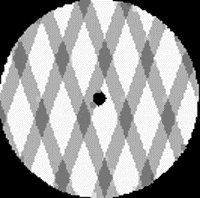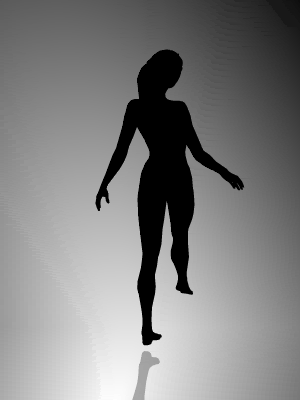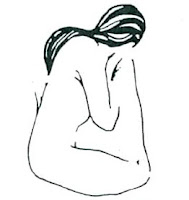The sixth in my series of posts on consciousness. All the posts are
indexed here.
Background: Why do we need psychology?Instead of just diving into the neural data, let's take some time to examine our target, consciousness. Clarifying the features of conscious awareness will provide a more precise target for our neuronal theories.
The ultimate goal is to develop an understanding of consciousness at both the neuronal and psychological levels. The two approaches should coevolve until they fit together as nicely as our ideas about trait inheritance and DNA, as well as our ideas about action potential generation and single channel biophysics.
To flesh out the analogy with inheritance/DNA, let's consider the work of Gregor Mendel. By controlling the reproduction of different strains of pea plants, Mendel was able to measure many features of inheritance well before anybody had heard of DNA. His work provided an explanatory target for molecular biologists who unraveled the mechanisms only much later. Similarly, psychologists have gained quite a bit of knowledge of consciousness by simply studying consciousness, knowledge gained without focusing much at all on the specific neuronal mechanisms involved.
There are literally thousands of psychological experiments and clinical studies that reveal interesting features of consciousness. Obviously, we'll only be able to look at a tiny subset of these data. This means I'll need to curate the data with some caution: I must be wary of cherry picking, or focusing only on data that lets me push some pet theory. The right approach toward any pet hypothesis is to try to kill it with data. We should actively seek out falsifying evidence, not data that confirms what we already believe.
We have to start somewhere in this galaxy of data, so let's begin with a set of illusions that has entertained and puzzled psychologists, and the general public, for nearly 200 years: ambiguous stimuli. I start with them partly for their cocktail party value, but also because they are an excellent gateway into the psychology of conscious perception.
Ambiguous Visual Stimuli and Bistable PerceptionA stimulus is ambiguous when it can evoke different percepts. That is, even though the stimulus is unchanging, our experience of the stimulus oscillates between two "interpretations." The alternating perceptual experiences are known as
bistable percepts. (If this is confusing, hold on: many examples are coming up).
In this post I'll focus on cases in which the percepts switch back and forth between two identical objects (e.g., two cubes) that are seen from two different perspectives. They are often called 'reversible figures.'
Necker cubeThe Necker Cube is probably the most famous reversible figure. It was first discussed in print in 1832 by a Professor of Minerology, LA Necker (Necker, 1832). The Necker Cube is at the top of the following figure. Looking at the line drawing tends to evoke alternating experiences of two cubes. These cubes are shown, in an unambiguous form, below the Necker Cube.

Perceptually, one of the cubes appears to come out of the page pointing down toward the left (the pink cube on the left), while the other cube appears to come out of the page pointing up to the right (the pink cube on the right).
While most people's visual system automatically generates a percept of one of the cubes (an amazing fact in itself), some people tend to stay locked into one interpretation. That is, they don't spontaneously experience bistability. If this is you, just keep staring and your percept will eventually switch. The longer you look at a reversible figure, the more frequently the perceptual alternation will occur.
Reversible SteepleIt is relatively easy to generate ambiguous drawings similar to the Necker Cube: make a line drawing of an arbitrary 3-D polygon and it is likely to generate bistable percepts. For instance, here is a five-sided solid, the Reversible Steeple:

One of the steeples points toward you (with the rectangular base further away), while the other points away (its base will be closer to you).
Schröder's StaircaseThe following figure should appear as a set of steps with either the blue or the pink "wall" closer to you.

When the red wall is closest, it seems you are looking at a staircase from above (the more standard perspective such as when you are approaching a set of stairs to climb). When the blue wall appears closest, it will seem as if you are looking up at a staircase from underneath, or an upside-down staircase, or an overhanging unfinished brick wall (the latter two descriptions are from Wallin's book).
Plush ChairYou can imagine the following is one of those plush velvet chairs with brass buttons on the front and back.

One percept is of a chair facing you: you see the chair from above with the backrest facing you and the seat of the chair is coming out toward you. The other percept is of a chair facing away from you: you see the chair from below, with the back of the backrest facing you and the seat is going away from you.
Inverting Hairbrush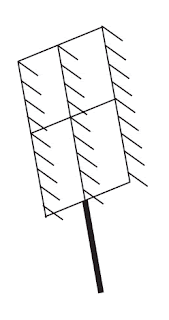
It appears to be a hair brush. It can appear either with the bristles facing you, or the bristles facing away.
Scripture's BlocksThis is one of my favorite reversible figure in this post, one of the more vivid cases of bistability. The image should appear as a set of long rectangular blocks stacked upon each another.

In one percept, each block is oriented down to the left, capped on the bottom by a white face. The hatched shading is the top surface of each block. In the other percept, each block is oriented up to the right with its white face at the top. In this case, the hatched shading coats the front surface of each block.
The scope of perceptual reorganizationI'll finish by illustrating the deep and sometimes startling nature of the perceptual reorganization during alternation. We'll look at two modifications of the Necker Cube.
Arrowhead CubeI've placed two arrows on the "surface" of the Necker Cube below. Consider two questions. Are the arrows on the inside or outside surface of the cube? In what direction are the arrows pointing? As you probably guess, the answer depends on which cube you see!

When you see the down-left cube, then the arrows appear on the outside of the cube, and seem to point toward you. However, when you see the top-right cube, they appear to be painted on the inside surface of the cube, and to point backwards away from you.
Somehow, when the brain alternates between cubes, it takes note of additional features of the cube and integrates them into the percept in an appropriate way. It does this without you having to think about it, without you consciously knowing
how you do it.
Rotating Necker CubeThe final bistable percept is my favorite of the bunch, the Rotating Necker Cube. It is a picture of a cube that is rotated by the same amount (in the same direction) with each time step. You should see a rotating cube. Does the cube still show bistability even when rotating?

Not only does the Rotating Necker Cube still alternate, but when it alternates it reverses its apparent direction of rotation! Once the percept switches, our visual system interprets the exact same movement as rotation in the opposite direction.
I will be devoting a future post to the Necker cube, as it is such a rich source of ideas and data.
Where we are headedIn the next post (maybe even two) we'll continue looking at ambiguous stimuli. This post has been a quick list of reversible figures, without much theory or discussion of consciousness. We will ultimately use these illusions to brainstorm about the nature of visual consciousness. Then we'll have something more precise that we can target from a neuronal perspective.
Philosophical dessertJust as Mendel's laws were consistent with many possible molecular mechanisms, these visual illusions are consistent with any number of lower-level neuronal explanations. For that matter, the illusions considered in isolation are consistent with dualism (roughly speaking, dualists believe that the mind is not part of nature, that it is a different kind of thing altogether such as a soul). Illusions provide useful data that all people (not just neurophiles like myself) interested in consciousness should struggle to explain. Dualists of the world, get off of your armchairs!
Original Sources of IllusionsThe Reversible Steeple is adapted from John Wallin's wonderful monograph
Optical Illusions of Reversible Perspective published in 1905 (it is available free at Google Books). Schröder's staircase was first published in Schröder (1858). I got the idea for coloring the two walls of the staircase from
planetpurplex.com, a site full of optical illusions. The Inverting Hairbrush and Plush Chair are both adapted from Wallin (1905). Scripture's blocks were introduced by Scripture (1897), though the figure used above is taken from Wallin (1905). The Arrowhead Cube is adapted from Mason et al. (1973).
I am not sure who first noticed bistability in the Rotating Necker Cube. If anyone knows the background, please let me know. Wallin (pages 46-47) says Wheatstone looked at moving Necker Cubes, but it seems Wheatstone just held wire cubes in his hand and contemplated them while he moved them about (see Wheatstone (1838)). Neither Wheatstone nor Wallin remarked on the apparent reversal of rotation, so the first observation was likely after the publication of Wallin's monograph in 1905.
ReferencesMason, J, Kaszor, P, and Bourassa, C.M. (1973) Perceptual structure of the Necker cube.
Nature 244: 54-56.
Necker, LA (1832) Observations on some remarkable Optical Phænomena seen in Switzerland; and on an Optical Phænomenon which occurs on viewing a Figure of a Crystal or geometric Solid.
The London and Edinburgh Philosophical Magazine and Journal of Science (3rd Series) 1, No 5, 329-337.
Schröder, H (1858) Über eine optische Inversion bei Betrachtung verkehrter, durch optische Vorrichtung entworfener physischer Bilder.
Annalen der Physik und Chemie 181: 298-311. [Note last name sometimes spelled 'Schroeder' or 'Schroder']
Scripture, E.W. (1897)
The New Psychology. Walter Scott Ltd, London.
Wallin, J.E.W. (1905)
Optical Illusions of Reversible Perspective: A volume of historical and experimental researches. Stanton Call Press, Stanton IA.
Wheatstone, C (1838) Contributions to the Physiology of Vision.—Part the First. On some remarkable, and hitherto unobserved, Phenomena of Binocular Vision.
Philosophical Transactions of the Royal Society of London,
128: 371 - 394.
---------------------------------------
Table of Contents of posts on consciousness.
 Let's jump-start our thinking with a familiar example: your experience of the Necker Cube (shown on the right). This time, try looking at it with one eye. You should still experience perceptual bistability.
Let's jump-start our thinking with a familiar example: your experience of the Necker Cube (shown on the right). This time, try looking at it with one eye. You should still experience perceptual bistability.